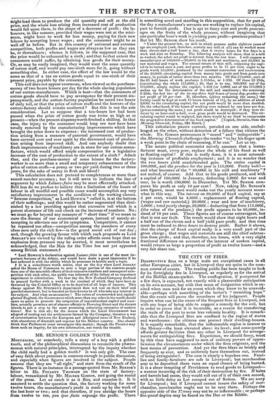MR. SENIOR'S GOLDEN TOOTH.
MONTAIGNE, or somebody, tells a story of a boy with a golden tooth, and of the philosophical discussions to reconcile the phwno- menon with natural principles, interrupted by the inquiry whether the child really had a golden tooth ? It was only gilt. The case of easy faith about premises is common enough in public discussion, and especially when figures are involved in the subject. People assume that they are " all right," and start from the result of the figures. There is an instance in a passage quoted from Mr. SENIOR'S letter to Mr. POULETT Tnomsort on the state of factory- labour, resuscitated by Mr. MILNER Casson, and going the round of the press. Let us catch it as it flies, and examine it. It is assumed to settle the question that, the factory working for some twelve hours, the manufacturer's profit is made up by the work of the last hour or two ; and that therefore, if you abridge the hours from twelve to ten, you ipso facto expunge the profit. There
is something novel and startling in this supposition, that for part of the day a manufacturer's servants are working to replace his capital, part to furnish profit. One is apt to fancy cost and profit percent- ages on the fruits of the whole process, without imagining that one particular hour's work is yielding pure profit—precious product ! But let Mr. SENIOR show his tooth.
" Under the present law, no mill in which persons under eighteen years of age are employed (and, therefore, scarcely any mill at all) can be worked more than eleven-and-a-half hours a day, that is twelve hours for five days in a week and nine on Saturday. The following analysis will show, that in a mill so worked, the whole net profit is derived from the last hour. I will suppose a manufacturer of 100,0001.-80,000/. in his mill and machinery, and 20,000/. in raw material and wages. The annual return of that mill, supposing the capi- tal to be turned once a year, and gross profits to be 15 per cent, ought to be goods worth 115,0001., produced by the constant conversion and reconversion of the 20,000/. circulating capital from money into goods and from goods into money, in periods of rather more than two months. Of this 115,000/, each of the 23 half-hours of work produces 5.115ths, or 1-23d. Of these 23 23ds, (constituting the whole 115,000/.0 20, that is to say, 100,000/. out of the 115,0001., simply replace the capital; 1-23d (or 5,0001. out of the 115,000/0 makes up for the deterioration of the mill and machinery; the remaining 2-23ds, the last two of the twenty-three half hours of every day, produce the net profit of 10 per cent. lf, therefore, (prices remaining the same,) the factory could be kept at work 13 hours instead of 111, by an addition of about 2,6001. to the circulating capital, the net profit would be more than doubled.. On the other hand, if the hours of working were reduced by one hour per day, (prices remaining the same,) net profit would be destroyed ; if they were re- duced by an hour-and-a-half, even gross profit would be destroyed. The cir- culating capital would he replaced, but there would be no fund to compensate the progressive deterioration of the fixed capital." [Copied, literatim, from the Morning Chronicle, Friday, 22d March.]
This calculation passes current, paraded on one side, unchal- lenged on the other, without detection of a fallacy that vitiates the whole. Mr. Gamma pronounces it " sound " and " indisputable " ; the Morning Chronicle challenges the reader "to lay his finger upon a weak point in the chain of reasoning, if he can." Let us try.
The astute political economist naively assumes that a manu- facturer must, every year, replace the whole of his fixed as well as floating capital ! if this is really done, it is a most astound- ing instance of profitable employment ; and it is no wonder that the two hours yield unadulterated gain. The entire capital is 100,0001., and the produce for the year is 115,0001. Pretty well!— and what becomes of the " 80,0001. in his mill and machinery " not melted, of course. Add that to his goods produced, and with a capital of 100,0001. in January, deducting 5,0001. for wear and tear, he is worth 190,0001. in December. Yet Mr. SENIOR com- putes his profit at only 10 per cent ! Now, taking Mr. SENIOR'S own figures, most men would make out the yearly account some- what in this way. The interest on 80,0001. of fixed capital, say at 5 per cent, would be 4,000/. ; replacement ef floating capital, (wages and raw material,) 20,000/. ; wear and tear of machinery, 5,000/. ; total yearly charge, 29,0001.: deducting that from 115,0001., (the value of the produce,) the profit appears to be 86,0001., in- stead of 10 per cent. These figures are of course extravagant, but that is not our fault. The result would show that eight hours and a half out of the eleven and a half yield pure profit, and that time must be reduced to three hours to destroy profit. Rather it shows, that the charge of fixed capital really is a very small part of the gross charge ; that wages and materials are still the chief subtrac- tion from profit ; and that, therefore, ten hours, with a very slight fractional difference on account of the interest of sunken capital, would return as large a proportion of profit as twelve hours—and a very fair share too.


























 Previous page
Previous page